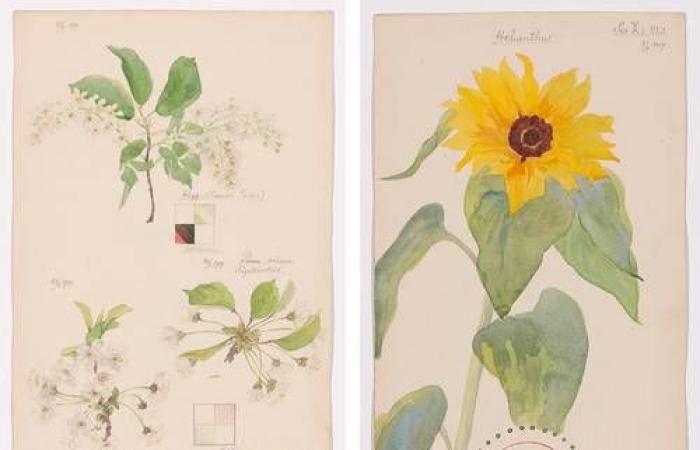Of the writing
La Jornada newspaper
Sunday, May 4, 2025, p. 3
Hilma AF Klint, visionary Swedish artist, demonstrated the connection between the plant world and that of the soul, as was manifested in the folder Nature studies that the Museum of Modern Art (MOMA) in New York exhibits for the first time in the exhibition What is hidden behind the flowers.
It is a flora of the spirit, a mapping of the natural world in spiritual terms that could be compared to any scientific resource
announces the museum the exhibition that opens on May 11, which shows another facet of the abstract art pioneer that has gained recognition in recent years.
A sunflower on a page accompanied by sober circles, a red narcissus crowned with a ring of primary colors and tree flowers along with a grid with points and strokes are an example of the naturalist’s talent with a vocation of scientific illustrator and the extension of the abstraction for which he is currently recognized.
The US Museum opens What Stands Behind the Flowers, that reflects the conviction that the study of nature reveals truths on the human condition
. Nature studies It is a portfolio composed of 46 botanical drawings that made AF Klint (1862-1944), recently acquired by MoMA, and that are shown for the first time, from May 11 to September 27.
Klint, who was born in 1862 in Solna, in northern Stockholm, ordered that his paintings, drawings and notebooks remain secret until 20 years after his death, considering that his work would not be understood. His death occurred in 1944 and his wishes his fulfillment. His nephew discovered the fascinating work in huge trunks containing 1,300 paintings, in addition to notebooks with annotations and thousands of pages written by machine. His paintings were a unique form of abstraction that Vasily Kandinsky, Piet Mondrian and Kazevich.
By combining geometric and organic shapes, he invented a distinctive artistic language now recognized as one of the first incursions of the early era of abstraction
Consider MoMA himself.
In 1986 the first exhibition was made with the work of Hilma AF Klint in Los Angeles. In 2018 was the Guggenheim Museum in New York, which organized an exhibition that attracted thousands of attendees, was at that time the most visited exhibition in the history of the museum.
For a few years these paintings have been exposed in several cities in the world, charging relevance along with their bulky writings.
The atom and human character
Hilma AF Klint grew in a family of sailors and cartographers. He attended the Royal Academy of Fine Arts in Sweden and was part of the first generation of European women who could study in art schools.
He stood out with landscape paintings in several collective exhibitions and worked as a scientific illustrator. He had orders that included anatomical illustrations of horses and drawings of fungal specimens.
In these representations, AF Klint masterfully captured the specificity of the color, texture and shape of its subjects, demonstrating its sensitivity towards nature and its ability to observe
describe the MoMA.
He also had interest in spiritualism, with belief in a kingdom beyond the visible, in accordance with theosophy and anthroposophy. These ideas were explored in their artistic practice and in their notebooks. In 1906 he accepted a commission of his Spiritual teachers
and made a monumental cycle, known as the Paints for the temple, with multiple colors that formed circles, ovals, lines, triangles and spirals.
Later, in 1917, he worked at the Atom series, in which he used the visual language of science to create abstract diagrams in order to represent the impossible to perceive with the naked eye; It also attributed moral conditions to the atom when connecting its form and energy with the human character. In 1925 he abandoned the painting completely.
Hilma AF Klint conducted his nature studies now exhibited in New York during the spring and summer of 1919 and 1920 with the intention of presenting the wonders of the Swedish flora, what the artist did with acute botanical vision, by combining an approach of abstraction with the traditional botanical drawing, a juxtaposition of the detailed representation of plants with enigmatic diagrams.
The exhibition focuses on 1917 to 1922, contextualizes the MoMA collection and highlights a fundamental change in the practice of AF Klint. Curator Jodi Hauptman pointed in a press release: “We hope that the tune – the demonstration of his careful observation and discovery of everything that hides behind the flowers – encourages the audience to look closely at seeing his own environment, whether here in the city or beyond, in new ways.”






